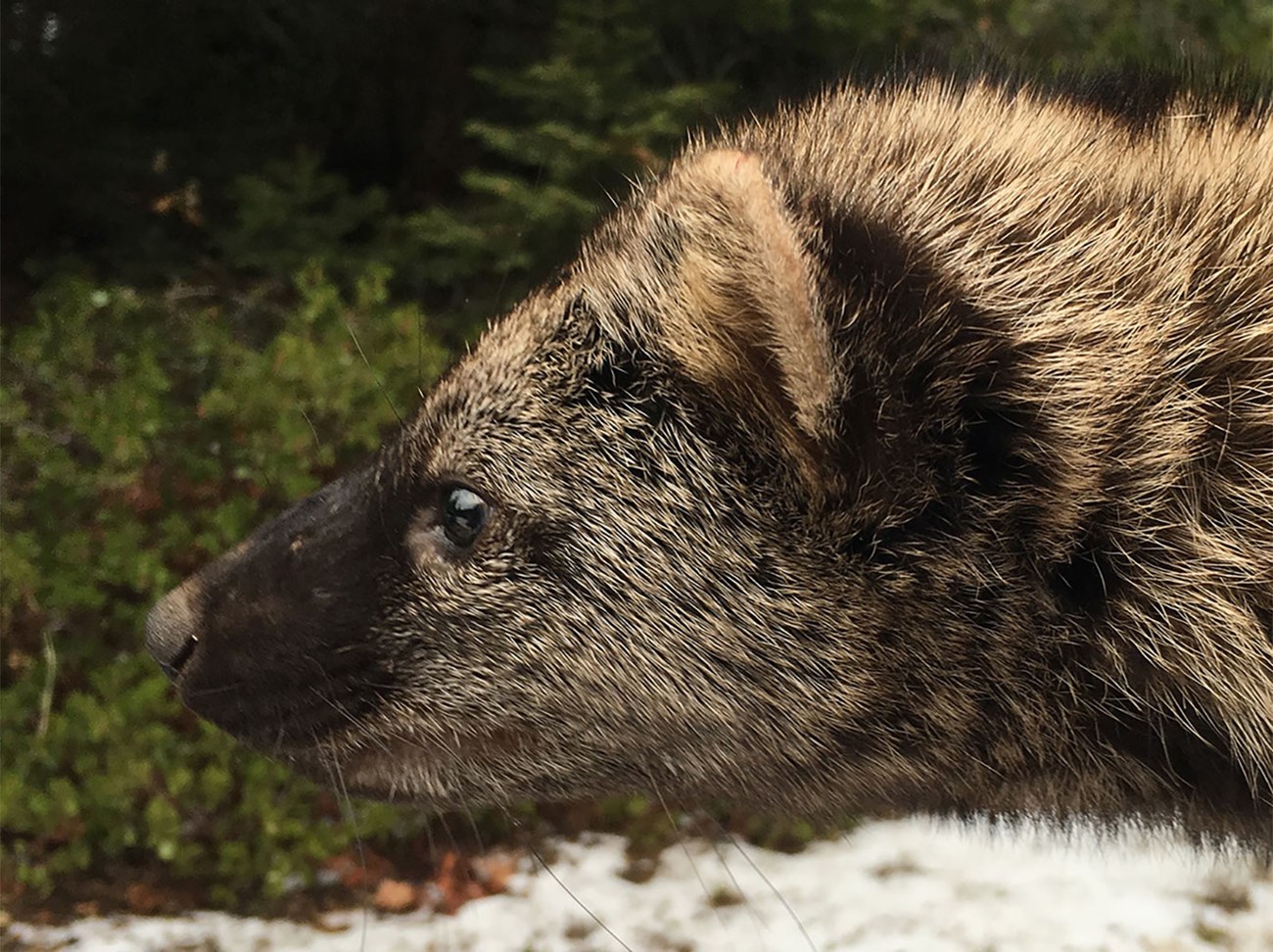
HistoryFishers are tree-dwelling carnivores that were once abundant throughout Washington, Oregon, and northern California. Fishers have been extirpated from more than 50% of their previous range and only two native populations survive in California, one near the California-Oregon border and one in the southern Sierra Nevada. Although fishers have faced many threats in the past, biologists are trying to ensure that these fierce little creatures will survive the big challenges ahead. The decline of fisher populations began in the 1800s when there was an increase in the market for luxurious pelts. Many members of the mustelid family including fisher, mink, and otter were hunted nearly to extinction. California banned trapping of fishers in the 1940s but their numbers have continued to decline because of habitat loss from logging, development, and severe forest fires. More recently, prolonged drought conditions and bark beetle infestations have led to increased loss of mature forest stands that are critical habitat for the small population of fishers that live in the southern Sierra Nevada. Other factors contributing to the decline of fisher populations are predation, vehicular strikes, disease, and poisoning from rodenticides remaining in the forest at illegal marijuana grow sites. The southern Sierra Nevada fisher population has been isolated from their northern relatives for thousands of years. Geographical isolation has made this fisher population genetically unique and vulnerable to decline. This small population of 150 to 300 fishers was previously determined to stretch from the Merced River in Yosemite to the southern parts of the Sequoia National Forest. In 2017, however, the first fisher north of the Merced River was detected and collared. Since then, several fishers have been monitored in this far northern end of the population, including the first documented denning female.

Research and ManagementConcerns over the health of fisher populations throughout the U.S. has spurred various research studies and have even led to the reintroduction of fishers in Olympic National Park, North Cascades National Park, Mount Rainier National Park in Washington, and the Stirling Management Area in the northern Sierra Nevada. In the southern Sierra Nevada, two studies have been gathering data on fishers since 2007: the Sierra Nevada Adaptive Management Project, later called the Sugar Pine Fisher Project and the Kings River Fisher Project. These surveys led to the discovery of the first known female fisher den in Yosemite in the spring of 2011. Researchers from the University of California, Berkeley, in collaboration with various federal and state agencies, initiated the Sierra Nevada Adaptive Management Project, which studied fishers from December 2007 through 2013. Between 2014 and 2016 the project shifted management from U.C. Berkeley to the U.S. Forest Service and was renamed the Sugar Pine Fisher Project. Yosemite biologists collaborated on fisher research in Yosemite from 2009-2015, with significant assistance from the Central Sierra Environmental Resource Center. The goal of these projects was to study the biology and monitor the movements of fishers within Yosemite and the Sierra National Forest. Methods included conducting camera surveys, monitoring female fisher dens, collecting data on den locations, documenting causes of mortality, and trapping and collaring fishers. Because of steep and sometimes inaccessible terrain, biologists tracked fisher locations using radio-telemetry from a fixed wing airplane that was flown over the study area four to five times a week. It was during one of these tracking missions in 2011, when biologists detected a female fisher within the boundary of Yosemite and later confirmed the first documented fisher den inside the park using motion-activated cameras. Between 2011 and 2016, five female fishers were documented denning in Yosemite and pictures of their kits have helped to confirm that protected lands within the park provide important habitat for the reproduction of this sensitive species. Yosemite and U.S. Forest Service biologists were also interested in identifying methods to reduce vehicle strikes and specifically placed motion-activated cameras on existing road culverts. We learned that fishers and other wildlife use existing culverts to cross safely under the roadway. Researchers are currently determining the characteristics of culverts used by wildlife. For example, we noticed animals did not use existing culverts during high spring run-off. Based on these observations, Yosemite biologists initiated the installation of wildlife-friendly culverts by adding safe crossing structures to existing culverts and installing new dry culverts along wildlife travel corridors. The Yosemite Conservancy and Federal Highways contributed funding to make this innovative work possible. 
In 2017, the Sierra Nevada Carnivore Monitoring Project detected a fisher north of the Merced River for the first time in almost a century. This led researchers within Yosemite National Park to capture the individual and fit it with a radio collar. In 2020, a more thorough camera survey was developed to canvas targeted riparian corridors that fishers may frequent. This was Phase 1 of a larger project designed to investigate the habitat selection and resiliency of fishers in a changing landscape. Phase 2, which is currently ongoing, involves live-trapping, collaring and monitoring fishers to assess their use of habitat in fire footprints and tree mortality areas. The results of this study will help inform the park in managing for a healthier forest, where the removal of high fuel loads and placement of prescribed burns on the landscape will ultimately benefit wildlife communities while reducing the threat of catastrophic wildfires. 
Visit our keyboard shortcuts docs for details
In 1946, trapping of fishers was banned in California — but at that point, their population numbers were so low that they still haven't recovered. Now, one of the biggest threats are large-scale wildfires. To find a fisher is pretty difficult — learn how wildlife biologists are working to study and save the elusive and endangered pacific fisher in Yosemite National Park. 
Biology and DescriptionFishers are tree-dwelling mammals that have long, slender bodies, long bushy tails, and short muscular legs with large feet and retractable claws, making them climbing specialists. Fishers are very agile and have specialized hind legs with feet that turn nearly backwards, giving them the ability to climb down trees head first. Fishers are highly associated with older, mid-elevation (3000 to 7000 feet) forests and prefer areas with large conifer and hardwood trees, interspersed with plenty of younger trees and downed logs. This complex forest structure is important, especially for female fishers who have their babies (called kits) in cavities of older trees and use the dense understory to forage for food and hide from predators. Fishers use multiple den trees when raising their kits and will move the kits to different dens to keep them clean, healthy, and safe from predators. Fishers in the southern Sierra Nevada most often use cavities and hollowed out areas of trees such as black oaks, incense cedar, white fir, ponderosa pine, and sugar pine to make their dens. While typically thought of as hunters, fishers readily forage upon insects and fruits, as well as a wide variety of prey, primarily small mammals and birds. Up to half of their summertime diet may consist of fungi, such as false truffles. Fishers are even wily enough to eat a porcupine if one crosses its path! Similar in size to a domestic cat, Pacific fishers weigh between 2 and 5.5 kilograms (4 to 12 pounds) and are members of the mustelid family, along with otter, mink, marten, wolverine, and badger. The fur of a fisher is very thick, soft, and shiny, has a distinct musky smell, and ranges in color from light blond to a rich, dark brown. 
ReproductionFisher reproduction is a unique process and is sometimes considered a limiting factor in their population viability. Fishers exhibit a polygynous mating system, mating with multiple individuals in one breeding cycle/season. Further, female fishers have a reproductive strategy called delayed implantation in which the eggs are fertilized during mating season between March and April, but the embryo does not begin to develop until approximately 10 months later. Although delayed implantation allows the female to arrest pregnancy during years of high stress, it also contributes to the lengthy reproduction time of the species. After implantation, the gestation period is approximately 40 days, so kits are born between March and April (one year after mating and just before the new mating season begins). The average litter size for fishers in the southern Sierra Nevada are two kits that are born blind and completely helpless. Their eyes open between 6 to 8 weeks and weaning occurs at 8 to 10 weeks. Kits remain with the mothers until the fall. Female fishers can mate within their first year, but most do not successfully give birth until the second or third year. Fisher reproduction strategies contribute to home range size differences between male and female fishers. Average male home ranges (2998 hectares) are more than twice the size of average female home ranges (527.5 hectares) in the Sierra Nevada, since males must maintain access to multiple females during the breeding season to ensure successful mating. Videos
|
Last updated: May 16, 2023

